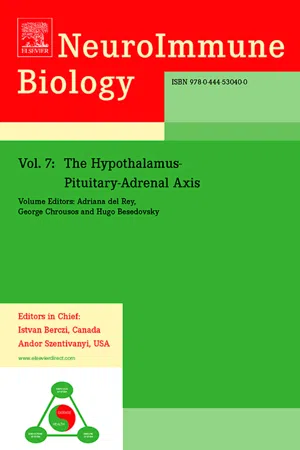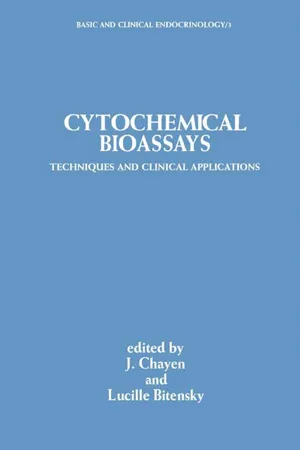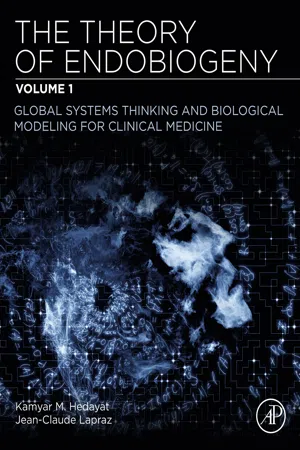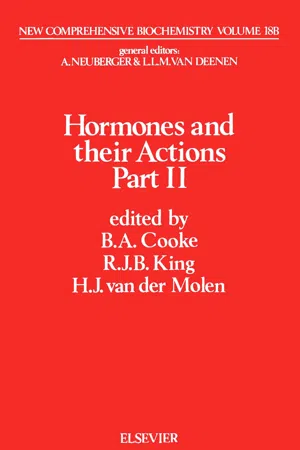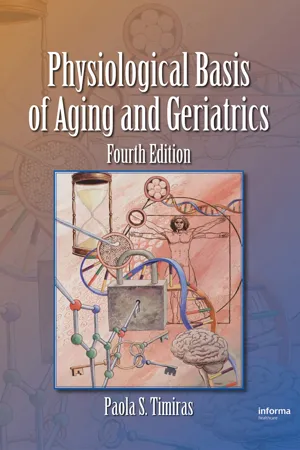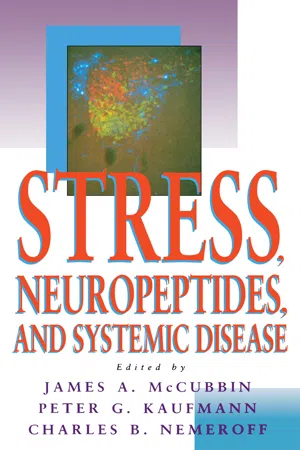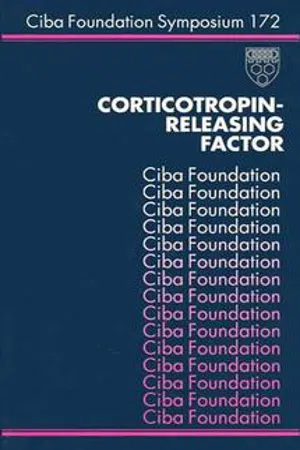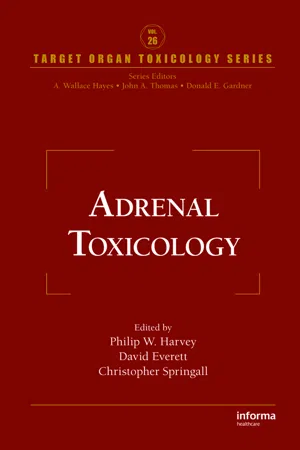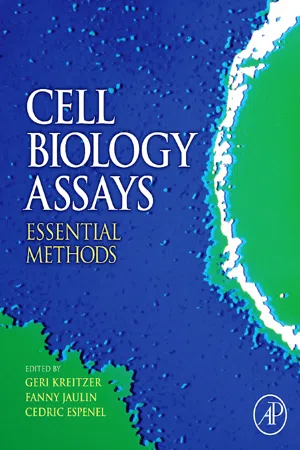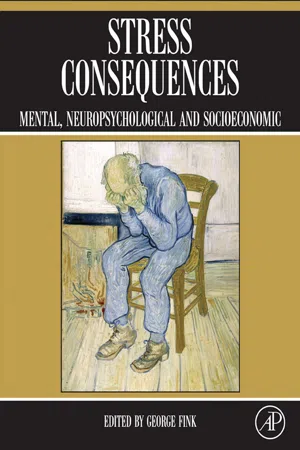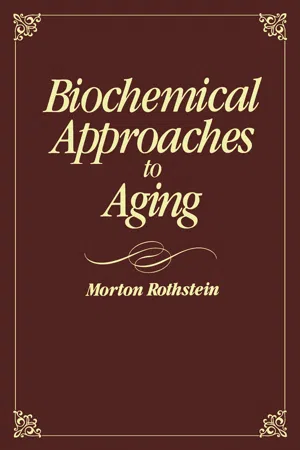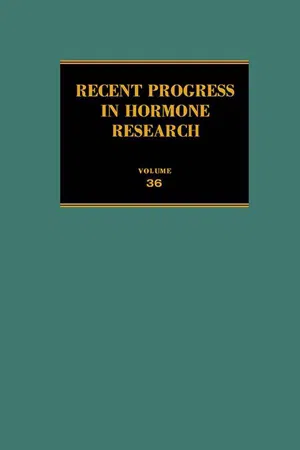Biological Sciences
Adrenocorticotropic Hormone
Adrenocorticotropic hormone (ACTH) is a hormone produced by the pituitary gland that stimulates the adrenal glands to release cortisol and other steroid hormones. It plays a crucial role in the body's response to stress and helps regulate metabolism, immune function, and blood pressure. ACTH levels are controlled by a complex feedback system involving the hypothalamus, pituitary gland, and adrenal glands.
Written by Perlego with AI-assistance
Related key terms
1 of 5
12 Key excerpts on "Adrenocorticotropic Hormone"
- eBook - PDF
- (Author)
- 2008(Publication Date)
- Elsevier Science(Publisher)
Following an increased secretion of corticotropin-releasing hormone (CRH) and arginine vasopressin (AVP) within the brain, the activation of the pituitary gland leads to the secretion of Adrenocorticotropic Hormone (ACTH), which in turn induces the release of corticosteroid hormones from the adrenal cortex. Multiple mediators also affect the HPA axis at all levels of biological organization, leading to distinct reactions of the key elements, to adequately respond to the type of stressor. The overall biological and psychological response of the organism under conditions of stress was termed “general adaptation syndrome.” If these responses persist or are inadequate, physiological immune, metabolic, and cardiovascular functions may be compromised. As a consequence, the individual may become more vulnerable to stress-related somatic and also neuropsychiatric disorders. Moreover, pathological reactions within the HPA system such as neuroendocrine disturbances and regulatory dysfunctions with a disinhibition and dysregulation of HPA axis functions may lead to inherent disease symptoms within the HPA system. ABBREVIATIONS ACTH Adrenocorticotropic Hormone AVP arginine vasopressin BNST bed nucleus of the stria terminalis CNS central nervous system CRF corticotropin-releasing factor CRH corticotropin-releasing hormone GR glucocorticoid receptor The Hypothalamus–Pituitary–Adrenal Axis 17 Edited by A. del Rey, G. P. Chrousos and H. Besedovsky HPA hypothalamic–pituitary–adrenocortical axis IL-1 b Interleukin-1 b IL-6 Interleukin-6 LPS lipopolysaccharide MR mineralocorticoid receptor NE norepinephrine PVN paraventricular nucleus SCN suprachiasmatic nucleus 1. INTRODUCTION 1.1. The HPA axis represents one of the mediators of the stress reaction Living organisms are continuously in dynamic contact with their environment. - eBook - ePub
Cytochemical Bioassays
Techniques and Clinical Applications
- J Chayen, Lucille Bitensky(Authors)
- 2013(Publication Date)
- Butterworth-Heinemann(Publisher)
4Adrenocorticotropic Hormone
W.H.C. Walker, McMaster University Medical Centre, Hamilton, Ontario, CanadaPublisher Summary
This chapter provides an overview of human Adrenocorticotropic Hormone (ACTH), which is a polypeptide of molecular weight 5250, composed of 39 amino acid residues in a single chain with no disulfide cross-linkages. Pituitary synthesis, storage, and release of ACTH is influenced by stress, by circulating levels of corticosteroids, and by a 24-hr cyclic rhythm that responds slowly to night-day changes and to sleep patterns. The sequence of events leading to corticosteroid secretion following ACTH binding to specific cell surface receptors is rapid, an increase in secretion occurring within 1 min of ACTH stimulation. ACTH activates adenyl and guanyl cyclases, resulting in the formation of adenosine 3′,5′-cyclic monophosphate and guanosine 3′,5′-cyclic monophosphate, and the increase of cyclic nucleotides occurs at least as rapidly as the release of corticosteroid. Other effects of ACTH include increase of glucose oxidation, phosphate turnover, protein turnover, cholesterol uptake, and synthesis of RNA and DNA.ADRENOCORTICOTROPIN: STRUCTURE AND FUNCTION
Chemical Structure and Synthesis
Human Adrenocorticotropic Hormone (ACTH) is a polypeptide of molecular weight 5250, composed of 39 amino acid residues in a single chain with no disulfide cross-linkages. Its biological activity resides in the sequence of its first 24 N-terminal amino acid residues, and this sequence is identical in all species that have been studied. The same 24-amino acid sequence is available in synthetic form (Synacthen, Tetra-Cosactryn, or Cortrosyn) and is widely used in clinical practice. Minor changes in this sequence may have profound effects; for example, oxidation of the methionine at position 4 can cause a marked reduction in activity.The C-terminal part of the ACTH molecule varies in beef, sheep, pig, and human at residues 31 and 33 (Riniker et al., 1972 ). Human corticotropin has been completely synthesized (Bajusz et al., 1967 ), and several analogs have been prepared which have higher biological activity than the natural hormone, probably because of their relative resistance to peptidase cleavage and longer circulating half-life. The nomenclature of ACTH precursors, analogs and fragments is complex, and usage generally follows the proposals of Li (1959) and of the IUPAC-IUB Commission of Biochemical Nomenclature (1967) - eBook - ePub
The Theory of Endobiogeny
Volume 1: Global Systems Thinking and Biological Modeling for Clinical Medicine
- Kamyar M. Hedayat, Jean-Claude Lapraz(Authors)
- 2019(Publication Date)
- Academic Press(Publisher)
Encyclopedia of Reproduction . 2nd ed. Elsevier; 597–606. 2018;vol. 2.43 Mastorakos G., Antoniou-Tsigkos A. Adrenocorticotropic Hormone (ACTH): physiology and its involvement in pathophysiology . In: Huhtaniemi I., Martini L., eds. Encyclopedia of Endocrine Diseases . 2nd ed. Elsevier; 48–55. 2018;vol. 3.44 Qi J., Yang J.Y., Song M., Li Y., Wang F., Wu C.F. Inhibition by oxytocin of methamphetamine-induced hyperactivity related to dopamine turnover in the mesolimbic region in mice . Naunyn Schmiedeberg's Arch Pharmacol . 2008;376(6):441–448.45 Vizi E.S., Volbekas V. Inhibition of dopamine of oxytocin release from isolated posterior lobe of the hypophysis of the rat; disinhibitory effect of beta-endorphin/enkephalin . Neuroendocrinology . 1980;31(1):46–52.46 Ishimoto H., Jaffe R.B. Development and function of the human fetal adrenal cortex: a key component in the feto-placental unit . Endocr Rev . 2011;32(3):317–355.47 Hinson J., Raven P., Chew S. The adrenal glands part I: the adrenal medulla . In: Hinson J., Raven P., Chew S., eds. The Endocrine System . 2nd ed. Churchill Livingstone; 2010:53–60 [chapter 5].48 Hannah-Shmouni F., Koch C.A. Adrenal Cortex; Physiology . In: Huhtaniemi I., Martini L., eds. Encyclopedia of Endocrine Diseases - eBook - PDF
Hormones and their Actions, Part 2
Specific action of protein hormones
- B.A. Cooke, R.J.B. King, H.J. Van Der Molen(Authors)
- 1988(Publication Date)
- Elsevier Science(Publisher)
B.A. Cooke, R. J.B. King and H.J. van der Molen (eds.) Hormones and their Actions, Purr I1 @ 1988 Elsevier Science Publishers BV (Biomedical Division) 193 CHAPTER 10 The mechanism of action of ACTH in the adrenal cortex PETER J. HORNSBY Department of Cell and Molecular Biology, Medical College of Georgia, Augusta, GA 30912, U.S.A. 1. ACTH and the cyclic A M P intracellular messenger system 1.1. The intracellular messenger for ACTH ACTH (Adrenocorticotropic Hormone, corticotropin) is a 39-amino-acid peptide synthesized and secreted by the corticotrope cells of the anterior lobe of the pitui- tary gland. ACTH acts on several target tissues, including the adrenal cortex, adi- pose tissue and brain. It is synthesized as part of proopiomelanocortin (POMC) as amino acids 132-170 of this molecule, which is proteolytically cleaved to produce ACTH [ 11. ACTH stimulates the synthesis of steroids by the cells of the adrenal cortex. The steroidogenic action of ACTH is mediated primarily by the intracellular messenger cyclic AMP acting via cyclic AMP-dependent protein kinase. The evidence for this is that (i) ACTH stimulates cyclic AMP production in intact adrenocortical cells and in plasma membrane preparations; (ii) cyclic AMP analogues added to adrenocor- tical cells stimulate steroidogenesis to the same extent as ACTH; and (iii) mutant adrenocortical cells with defective cyclic AMP-dependent protein kinase lack stim- ulation of steroidogenesis by ACTH [2]. Although the primary mode of action of ACTH is via cyclic AMP and cyclic AMP- dependent protein kinase (A-kinase), calcium probably plays a secondary role in enhanciag and modulating the action of ACTH via the A-kinase pathway. This is discussed later in the consideration of the interaction of the A-kinase pathway of activation by ACTH and other second messenger systems involving calcium and protein kinase C. - eBook - PDF
- Paola S. Timiras(Author)
- 2007(Publication Date)
- CRC Press(Publisher)
Abbreviations: ACTH, Adrenocorticotropic Hormone; CRH, corticotropin- releasing hormone; E, epinephrine; NE, norepinephrine; NGF, nerve growth factor. 152 n Timiras and Gersten Taiwan that included individuals between the ages of 54 to 91. Contrary to expectation, a number of indicators of a stressful life history (e.g., low education, widowhood, living alone, sub- jective reports of familial stress) were not linked to an allostatic load measure that focused on the neuroendocrine biomarkers (21). One interpretation of these results is that given a life history of challenge, at older age, the body still retains its ability to maintain homeostasis and respond to new types of stress (97). According to the concept of hormesis, small (moderate) doses of stress have stimulatory actions that provide benefits for the organism (Box 4) (81). As mentioned in Chapter 3, manipulation of metabolic or hormonal signaling in various animal species increases longevity as well as resistance to stress. Thus, stress may have two different types of influences, positive and negative. This dual action is reminiscent of Janus, the Roman god whose statue was placed outside the gate of large and small Roman cities. One face, smiling and benevolent, looked toward the town, presumably wishing prosperity and health. The other face, frowning and malev- olent, looked toward the surrounding countryside, presum- ably intimidating any would-be attackers. In other words, in humans, a moderate stress of short duration may be protective, whereas a severe stress of long duration may be harmful (Fig. 16). FIGURE 14 During stress, the priorities of the secretions of the hypothalamo-pituitary-peripheral endocrine axes are shifted in favor of the HPA axis. During stress, whereas the HPA axis is stimulated, the secretion of the other hormones is drastically reduced. This shift may explain the decrease in growth and insufficiency of gonadal function during stress. - eBook - PDF
- James McCubbin(Author)
- 2012(Publication Date)
- Academic Press(Publisher)
A. Role of CRF and Vasopressin in Regulating the ACTH Response to Various Types of Stress CRF appears to be the major factor modulating the ACTH response to stress with vasopressin also playing a role. ACTH responses to hemody-namic stimuli and insulin-induced hypoglycemia exemplify this type of reg-ulation (Antoni, 1986). B. Hemodynamic Stimuli Hemorrhage increases the secretion of ACTH. Carlson and Gann (1984) studied the ACTH response to hemodynamic stimuli in cats and showed that in animals pretreated with dexamethasone the ACTH response to he-modynamic stress was preserved, indicating that the ΗΡΑ response to this 2. Hypothalmo-Pituitary-Adrenal Axis Regulation 27 stimulus is steroid nonsupressible. They then showed that vasopressin anti-serum attenuated the increase in plasma ACTH evoked by hemorrhage. Hy-pophyseal portal blood collections in the rat have also shown that hemor-rhage increases vasopressin concentrations. Thus ACTH responses to hemodynamic stimuli appear, at least in part, to be regulated by vaso-pressin. C. Insulin Stress Insulin-induced hypoglycemia is also a potent stimulus for ACTH secretion. The full ACTH response to this stimulus requires the presence of catechola-mines, CRF, and a marked rise in vasopressin. In the rat, the principal medi-ator of the ACTH response to insulin has been shown to be an increase in vasopressin release (reviewed by Antoni, 1986). III. Central Regulation of the ΗΡΑ Axis The details of the neural pathways and mechanisms subserving the control of the hypothalamo—pituitary-adrenal axis are obscure. In the last few years there has been some progress in defining these pathways and their neurotransmitters. A number of brain structures have been implicated in the regulation of the hypothalamo—pituitary-adrenal axis. These include the amygdala, the hippocampus, septal area, cingulum, orbital, and brain-stem regions. - eBook - PDF
- Derek J. Chadwick, Joan Marsh, Kate Ackrill, Derek J. Chadwick, Joan Marsh, Kate Ackrill(Authors)
- 2008(Publication Date)
- Wiley(Publisher)
Hypothalamo-pituitary-adrenal axis Effects of cytokines or immune activation Administration of various cytokines and experimental induction of increased endogenous cytokine production by treatment with endotoxins or viruses stimulates secretion of Adrenocorticotropic Hormone (ACTH), corticosterone and &endorphin in the rodent (reviewed in Bateman et a1 1989, Dunn 1990, Busbridge & Grossman 1991). Our original finding that these changes are accompanied by increased release of corticotropin-releasing factor (CRF) into the hypophysial portal circulation (Sapolsky et al 1987), as well as the observation that immunoneutralization of endogenous CRF abolishes IL-1 induced ACTH release (Berkenbosch et a1 1987, Sapolsky et a1 1987), indicated the crucial role of CRF in cytokine-mediated activation of the HPA axis. Further support for such a role has been provided by studies showing that IL-1 stimulates expression of the CRF gene and/or production of the peptide in the hypothalamus (Berkenbosch et a1 1987, Barbanel et a1 1990, Ju et a1 1991). 206 Rivier & Rivest Mechanisms mediating the activation of the HPA axis Cytokines exert a plethora of effects, many of which characterize the early part of the immune response, called the acute-phase response (Kushner 1982). Among these effects, augmented prostaglandin secretion-a phenomenon linked to the occurrence of fever (Dinarello & Wolff 1982)-increases in peripheral (Berkenbosch et all989, Rivier et al1989b) and brain (Dunn 1988, Matta et a1 1990) catecholamine levels as well as in endogenous opiates (Brown et a1 1987) have suggested these secretagogues as possible mediators of cytokine-induced activation of the HPA axis. Prostaglandins, endogenous opiates, catecholamines and serotonin. Many biological effects of cytokines are mediated through the secretion of prostaglandins (PGs) (Dinarello 1988). - eBook - PDF
- Philip W. Harvey, David J. Everett, Christopher J. Springall, Philip W. Harvey, David J. Everett, Christopher J. Springall(Authors)
- 2008(Publication Date)
- CRC Press(Publisher)
Stress-Induced Activation of the HPA Axis The HPA axis plays a critical role in enabling the organism to prepare for, respond to, and cope with physical or psychological stress. The mechanisms by which different stresses promote the release of CRH and AVP are a subject of much current research as too are the processes which underlie the adaptive responses to repeated or chronic stress. Acute Stress It is now broadly established that stresses which have a psychological component use cortico-limbic pathways to drive the HPA response while those that are “phys-ical” in nature, e.g., hypotension, use the ascending noradrenergic pathways which project from the brain stem nuclei (A1 in the ventrolateral medulla and A2 in the nucleus tractus solitarius) to the PVN. This dogma is well supported by data from studies involving, for example, measurement of the stress-induced expression of the immediate early gene, c-fos , in discrete brain regions or of c-fos and CRH mRNAs in the PVN of animals in which the relevant ascending or descending neuronal inputs to the PVN have been lesioned surgically or pharmacologically. These studies have emphasized repeatedly the critical role of the amygdala, hip-pocampus, and bed nucleus stria terminalis in mediating the responses to acute psychogenic stressors (e.g., restraint), and the supporting roles of cortical regions, most notably the prefrontal and cingulate cortices. Among the most potent activators of the HPA axis are insults to the host defence system (e.g., infections and other immunological insults), which threaten the well-being of the organism. The mechanisms by which such assaults trigger the release of glucocorticoids have been hotly debated. Early studies exploring the responses to bacterial (injection of lipopolysaccharide, LPS) or viral (e.g., Newcastle disease) toxins pointed to cytokine-dependent mechanisms which trigger the release of CRH and, possibly, AVP from the hypothalamus (Sapolsky et al. , 1987). - eBook - ePub
Cell Biology Assays
Essential Methods
- Fanny Jaulin, Cedric Espenel(Authors)
- 2009(Publication Date)
- Academic Press(Publisher)
2+ -and phospholipids-binding protein strongly implicated in the anti-inflammatory and antiproliferative actions of the steroids. The genes encoding POMC in the pituitary gland and CRH/AVP in the parvocellular PVN neurons may also be repressed during the early delayed phase of feedback; however, the consequent downregulation of ACTH, CRH, and AVP synthesis emerges relatively slowly and, with existing techniques, is not normally discernible until some hours after the onset of inhibition of peptide release. Late delayed feedback is characterized by the inhibition of the synthesis and the release of CRH/AVP and ACTH in the hypothalamus and anterior pituitary gland, respectively. The inhibition of synthesis again reflects the inhibitory influence of the steroids on the genes encoding each of the three peptides, but the concomitant inhibition of peptide release cannot be explained fully in this way because peptide stores are rarely fully depleted.Short loop and ultrashort loop feedback mechanismsIn addition to the corticosteroids, other hormones of the HPA axis participate in the feedback regulation of ACTH secretion. Of particular importance are the POMC-derived peptides, ACTH and β-endorphin, both of which have been shown to exert powerful inhibitory actions on the secretion of CRH/AVP by the hypothalamus. Because neither peptide penetrates the blood–brain barrier readily, their short loop feedback actions are probably exerted at the level of the median eminence, which lies outside the blood–brain barrier. Ultrashort loop feedback actions have been attributed to both CRH and AVP, but the physiological significance of such responses is unclear.Glucocorticoid Secretion in Repeated or Sustained Stress
The bulk of studies on stress and HPA function have focused on acute stresses, and relatively little is known of either the characteristics or the mechanisms controlling the HPA responses to repeated or sustained stress. Such conditions are, of course, inherent to our lifestyle and environment, and a deeper understanding of their influence on neuroendocrine function is thus highly desirable. However, for both ethical and practical reasons, it is difficult to develop appropriate animal models and, as described later, the available data suggest that the profile of the HPA responses observed may vary considerably according to the nature of the stress.In some cases, HPA responses to repeated (successive or intermittent) or sustained (chronic) stressful stimuli are attenuated. For example, tolerance develops to stresses such as cold, handling, saline injection, or water deprivation (induced by the replacement of drinking water with physiological saline). Some degree of cross-tolerance may occur between stresses that invoke similar pathways/mechanisms to increase CRH/AVP release. Thus, for example, repeated handling reduces the subsequent adrenocortical response to a saline injection; however, rats tolerant to the C fiber-dependent stress of exposure to a cold environment respond to the novel stress immobilization with a normal or even exaggerated rise in serum corticosterone. In other situations, however, tolerance does not develop; thus, HPA responses to intermittent stresses of electric foot shock, insulin hypoglycemia, or IL-1β are maintained or even enhanced, as are those to the chronic stress of septicemia. - eBook - ePub
Stress Consequences
Mental, Neuropsychological and Socioeconomic
- George Fink(Author)
- 2010(Publication Date)
- Academic Press(Publisher)
Many functions of living creatures are subject to periodic or cyclic changes mainly influenced by the nervous system. These changes are instrinsic to the organism independent of the environment and are driven by a biologic “clock”. When they have a period of approximately 24 hours these rhythms are called circadian (around a day).CytokinesSubstances secreted from a number of different immune, including activated macrophages and lymphocytes, and nonimmune cells. According to their subtype they may exert a pro- or anti-inflammatory effect and activate the stress response.Cushing’s syndrome The presence of symptoms and signs associated with prolonged exposure to inappropriately elevated levels of free plasma glucocorticoids.GlucocorticoidsThe final endocrine effectors of the hypothalamic-pituitary-adrenal (HPA) axis. They are steroid pleiotropic hormones that exert their effects through ubiquitously distributed intracellular receptors. Glucocorticoids are crucial for the maintenance of resting and stress-related homeostasis, regulating and assuring the integrity of cardiovascular, metabolic, behavioral and immune homeostasis.Metabolic syndromeA clustering of factors closely associated with the development of atherosclerotic cardiovascular disease. The most recent definition includes central obesity, hypertriglyceridemia, low high-density lipoprotein (HDL) cholesterol levels, hypertension, and increased fasting glucose levels or diabetes mellitus type 2.StressState of threatened or perceived threatened homeostasis. Stress can be of either physical, social and/or psychological origin. During stress, a coordinated adaptive response of the organism is activated that is crucial in achieving and maintaining homeostasis. If this response is excessive and prolonged or defective and inadequate, the organism is in dyshomeostasis, or allostasis (allo = different) or cacostasis (caco = bad). The main components of the adaptive response are the corticotropin-releasing hormone (CRH) and the locus-caeruleus-norepinephrine (LC-NE)/arousal and autonomic nervous systems and their peripheral effectors, HPA axis and the systemic and adrenomedullary limbs of the autonomic system. - eBook - PDF
- Morton Rothstein(Author)
- 2012(Publication Date)
- Academic Press(Publisher)
Hormones Chapter 10 I. OVERVIEW The process of neuorendocrine hormone action can be viewed as orig-inating from the hypothalamus in response to some stimulus, perhaps neural, chemical, or physical. Specific releasing factors or inhibitors from this tissue invoke a response in the pituitary gland which, in turn, may release Adrenocorticotropic Hormone (ACTH), thyrotropic hormone (THS), follicle-stimulating hormone (FSH), luteinizing hormone (LH), prolactin (PRL), or growth hormone (GH). These substances stimulate hormone production in target glands or tissues such as adrenal cortex, thyroid, testes, and ovary, or react directly with a target tissue to elicit metabolic responses. Any age-related change in the response of the hypothalamus, the pituitary, the target organs, or the tissue which is the final recipient of a given signal, could have a profound effect on metabo-lism. Obviously, changes at the top of this sequence would have far-reaching effects even if the glands and tissues at the lower levels retain their ability for normal response. As far as we know, there does not seem to be a generalized decline during aging, in the response of the hypothalamus or pituitary, although changes related to specific stimuli may occur. In addition to sequences of events generated by neuroendocrine stim-uli, there are other reactions mediated by hormones with nonneural function, which are independent of or under less direct pituitary con-trol. Of these, epinephrine, glucagon, and insulin have been studied with respect to aging. It is obvious that study of age-related changes in hormone metabolism can be directed toward several loci. One common approach is the inves-256 /. Overview 257 tigation of changes with age of receptors in target tissues. Binding de-creases in about 70% of the tissues studied, but it is rare that receptor affinity is altered. - eBook - ePub
Recent Progress in Hormone Research
Proceedings of the 1979 Laurentian Hormone Conference
- Roy O. Greep(Author)
- 2013(Publication Date)
- Academic Press(Publisher)
Stalk-dependent vascular transport of [ 3 H]ACTH-(4–9) to hypothalamus (measuring only radioactivity) has been reported (Mezey et al., 1978). The distribution of radioactivity, however, did not correlate exactly with that demonstrated for endogenous peptides (Dorsa et al., 1979). “Short loop” feedback regulation by pituitary hormones of their releasing factor has been proposed (Mangili et al., 1966) but by no means proved. Were this to occur, it might be accomplished by the postulated retrograde hypophysial portal plexus route, since there is no evidence that significant amounts of pituitary hormones are taken up by the brain when these hormones are injected intravenously. Whole brain uptake is reported to be less than 1% (Nicholson et al., 1978) and 0.07% (Mezey et al., 1978) after the intravenous injection of tritiated ACTH or ACTH analog. E REGULATION AND FUNCTION OF CENTRAL NERVOUS SYSTEM ACTH-RELATED PEPTIDES With the demonstrated evidence of synthesis and, to a limited degree, processing of the “ACTH” precursor molecule in brain, the question arises as to what factors regulate such synthesis, processing, and action. The preceding section has considered factors regulating the pituitary concentrations of these peptides. We (Krieger et al., 1979b) and Orwoll et al. (1979) have reported that neither adrenalectomy nor corticosteroid administration significantly alter hypothalamic concentrations of immunoreactive ACTH material (Figs. 22A and 22B). We have further shown that such concentrations are not altered by the stresses of ether administration or chronic immobilization—procedures associated with alterations in pituitary and plasma ACTH concentrations. Whole brain concentrations of β-endorphin-like material are not affected by adrenalectomy (Rossier et al., 1977a); foot shock stress is associated with decreased β-endorphin-like immunoreactivity in hypothalamus, but not in other brain areas (Rossier et al., 1977b). FIG
Index pages curate the most relevant extracts from our library of academic textbooks. They’ve been created using an in-house natural language model (NLM), each adding context and meaning to key research topics.
